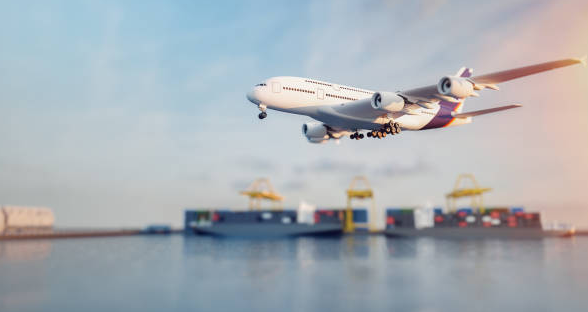
Early Beginnings: Origins of Air Freight Forwarding
The story of air freight forwarding finds its roots in the early 20th century when daring aviators began transporting mail and cargo across borders. The emergence of air cargo transportation during World War II further expedited the evolution, leading to the establishment of dedicated air cargo routes. Pioneering companies like Pan American World Airways (Pan Am) and Trans World Airlines (TWA) played instrumental roles in laying the groundwork for modern air freight forwarding services.
The Jet Age and Technological Advancements
The dawn of the jet age, marked by the introduction of commercial jet aircraft, propelled the air freight industry to new heights. Jet aircraft not only significantly reduced transit times but also expanded the cargo capacity. This era saw the development of cargo-specific airlines, recognising the distinct needs of freight transportation. Concurrently, technological innovations in cargo handling and tracking systems revolutionized logistics, ensuring efficient operations and enhanced customer service.
Globalisation and the Rise of Shipping Containers
As globalisation gained momentum, air freight forwarding evolved to meet the demands of rapidly growing trade volumes. The concept of containerisation, which revolutionized sea freight, also influenced air cargo. Standardisation and containerisation of cargo facilitated streamlined loading, unloading, and transhipment processes. The integration of multimodal transportation networks enhanced intermodal connectivity, bridging the gap between air, sea, and land transportation.
Regulatory Framework and Industry Associations
The complex nature of air freight forwarding necessitated the establishment of international regulations to ensure safety, security, and standardisation. Organisations like the International Air Transport Association (IATA) played a vital role in creating a cohesive framework for the industry. National and international regulations governed cargo handling, packaging, and documentation, ensuring seamless cross-border operations.
E-Commerce Revolution and Last-Mile Delivery
The digital age brought about an unprecedented revolution in commerce, with e-commerce emerging as a dominant force. This shift in consumer behaviour had a profound impact on air freight forwarding, demanding quicker and more flexible shipping solutions. The challenge of last-mile delivery emerged as a focal point, leading to innovative strategies such as drone and autonomous vehicle delivery, transforming the final leg of the supply chain.
Sustainability and Green Initiatives
As environmental concerns took centre stage, the air freight industry faced calls for sustainable practices. Air freight forwarding embraced green initiatives by adopting fuel-efficient aircraft, investing in alternative fuels, and implementing carbon offset programs. These efforts not only aligned with global sustainability goals but also positioned the industry as a responsible participant in the fight against climate change.
Data-Driven Logistics and Supply Chain Integration
Data emerged as a valuable asset in the evolution of air freight forwarding. Advanced data analytics enabled real-time tracking, visibility, and predictive insights, empowering stakeholders to make informed decisions. The integration of data-driven solutions with supply chain management systems fostered seamless coordination among various elements of the logistics chain, optimizing efficiency and customer satisfaction.
Challenges and Adaptations
Despite its successes, the air freight forwarding industry faced its share of challenges. Congestion at airports and capacity constraints demanded innovative approaches to manage the flow of goods. Stricter security regulations necessitated robust screening procedures. The industry showcased remarkable resilience during global crises, such as pandemics and economic downturns, adapting to new realities and ensuring the continuity of vital supply chains.
Future Prospects and Trends
As we look forward, the air freight forwarding industry is undergoing significant evolution. Automation and robotics are on the cusp of revolutionizing cargo handling, greatly enhancing efficiency while reducing human errors.
The exploration of drone and unmanned aerial vehicle (UAV) delivery holds immense promise, particularly in transforming last-mile logistics. In an increasingly interconnected global economy, the role of air freight forwarding in facilitating trade and fostering economic connections remains indispensable, further highlighting the importance of human-robot interaction.
Human Element: The People Behind Air Freight Forwarding
Behind the mechanized operations and technological advancements lies the human element that breathes life into air freight forwarding. Pilots, cargo handlers, freight forwarders, and an entire workforce collaborate to ensure the seamless movement of goods across the skies. Their dedication and expertise form the foundation upon which the industry thrives.
Impact on Society and Economy
Beyond its logistical significance, air freight forwarding has far-reaching impacts on society and the global economy. It facilitates the movement of goods critical for industries ranging from medical supplies to high-tech electronics. Air freight forwarding plays a role in disaster response and humanitarian aid, providing swift assistance to those in need. Moreover, it serves as an engine of economic growth, generating employment and fostering global prosperity.
Conclusion
The story of air freight forwarding is one of evolution, innovation, and resilience. From the pioneering aviators of the early 20th century to the data-driven logistics of the modern era, the industry has undergone remarkable transformation. The wings of change continue to propel air freight forwarding forward, weaving it into the fabric of global trade and shaping the interconnected world of tomorrow. As the industry adapts to new challenges and embraces emerging technologies, its role as a catalyst of progress remains unwavering, showcasing the boundless possibilities that lie ahead.







